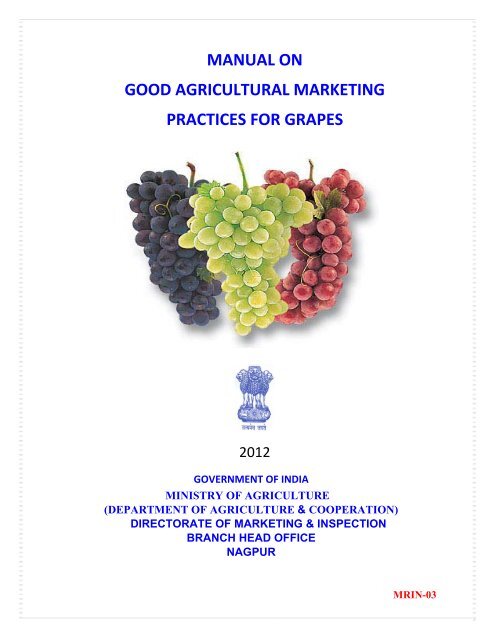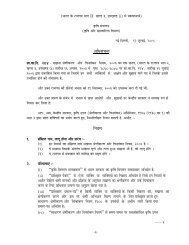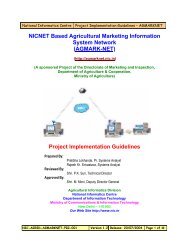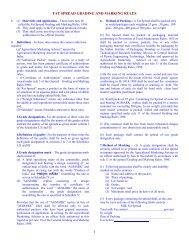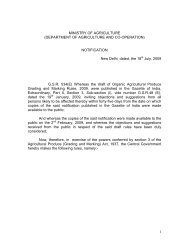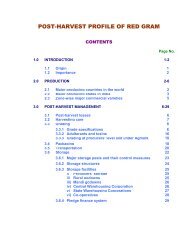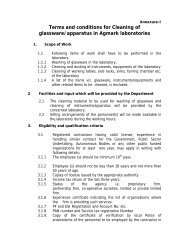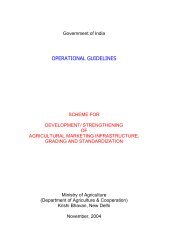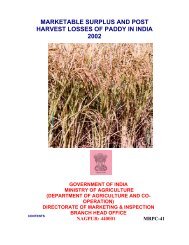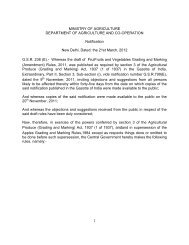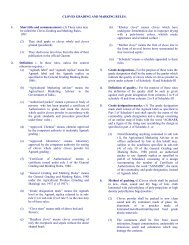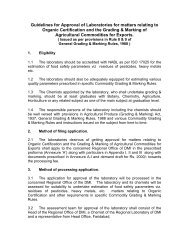Manual on good Agricultural Marketing practices for - Agmarknet
Manual on good Agricultural Marketing practices for - Agmarknet
Manual on good Agricultural Marketing practices for - Agmarknet
Create successful ePaper yourself
Turn your PDF publications into a flip-book with our unique Google optimized e-Paper software.
MANUAL ON<br />
GOOD AGRICULTURAL MARKETING<br />
PRACTICES FOR GRAPES<br />
2012<br />
GOVERNMENT OF INDIA<br />
MINISTRY OF AGRICULTURE<br />
(DEPARTMENT OF AGRICULTURE & COOPERATION)<br />
DIRECTORATE OF MARKETING & INSPECTION<br />
BRANCH HEAD OFFICE<br />
NAGPUR<br />
MRIN-03
PREFACE<br />
Grape is an important fruit crop in our country and world. Grape is the third<br />
most widely cultivated fruit after citrus and banana. Grapes are widely c<strong>on</strong>sumed as<br />
fresh fruit in India. It is also used <strong>for</strong> producing raisins, wine, juice, juice c<strong>on</strong>centrate,<br />
squash, beverages, jams and marmalades. Maharashtra is the largest producer of<br />
grapes in the country. Karnataka, Tamil Nadu, Andhra Pradesh and Punjab are<br />
other major grapes growing states.<br />
The Inter-Ministerial Task Force <strong>on</strong> <strong>Agricultural</strong> <strong>Marketing</strong> Re<strong>for</strong>ms in their<br />
report in May,2002, suggested several measures <strong>for</strong> undertaking various re<strong>for</strong>ms in<br />
the <strong>Agricultural</strong> <strong>Marketing</strong> System in the country. In view of the keen competiti<strong>on</strong> in<br />
the domestic as well as internati<strong>on</strong>al markets, it has become imperative to launch<br />
awareness programmes vigorously to up-date the technical know-how of various<br />
stakeholders involved in the marketing of farm produce in multi dimensi<strong>on</strong>al aspects<br />
of agricultural marketing system.<br />
In view of the above, “<str<strong>on</strong>g>Manual</str<strong>on</strong>g> <strong>on</strong> Good <strong>Agricultural</strong> <strong>Marketing</strong> Practices <strong>for</strong><br />
Grapes” has been prepared. This manual covers various aspects of post harvest<br />
management and marketing of Grapes.<br />
This “<str<strong>on</strong>g>Manual</str<strong>on</strong>g> <strong>on</strong> Good <strong>Agricultural</strong> <strong>Marketing</strong> Practices <strong>for</strong> Grapes” has<br />
been prepared by Shri MANOJ KUMAR, Assistant Agrilcultural <strong>Marketing</strong> Adviser<br />
under the guidance of Shri RAKESH SAXENA, Dy <strong>Agricultural</strong> <strong>Marketing</strong> Adviser,<br />
D.M.I. B.H.O., Nagpur.<br />
The Directorate of <strong>Marketing</strong> & Inspecti<strong>on</strong> acknowledges the assistance and<br />
co-operati<strong>on</strong> extended by various instituti<strong>on</strong>s/organisati<strong>on</strong>s in supplying the relevant<br />
data/in<strong>for</strong>mati<strong>on</strong> required <strong>for</strong> compilati<strong>on</strong> of this manual.<br />
The Govt. of India should not be regarded as assuming resp<strong>on</strong>sibility <strong>for</strong> any<br />
of the statements c<strong>on</strong>tained in this manual.<br />
-Sd-<br />
(Rajendra Kumar Tiwari)<br />
Faridabad <strong>Agricultural</strong> <strong>Marketing</strong> Adviser<br />
Dated : 05-03-2012 to the Government of India
MANUAL ON<br />
GOOD AGRICULTURAL MARKETING PRACTICES FOR GRAPES<br />
CONTENTS<br />
PAGE NO.<br />
1) INTRODUCTION 1<br />
2) IMPORTANT VARIETIES GROWN IN INDIA 1<br />
3) PRE-HARVEST, HARVESTING AND POST-HARVEST CARE 2<br />
4) GRADING 9<br />
5) PACKAGING 10<br />
6) TRANSPORTATION 11<br />
7) STORAGE 12<br />
8) IMPORTANT ASSEMBLING MARKETS 16<br />
9) MARKETING CHANNELS 17<br />
10) MARKET INFORMATION AND EXTENSION 17<br />
11) ALTERNATIVE SYSTEM OF MARKETING 19<br />
12) INSTITUTIONAL CREDIT FACILITIES 21<br />
13) ORGANISATIONS PROVIDING MARKETING SERVICES 22<br />
14) DO’S & DON’TS 23
Botanical Name: Vitis vinifera<br />
Family: Vitaceae<br />
1.0 INTRODUCTION<br />
GRAPES<br />
Grape is <strong>on</strong>e of the important fruit crop grown in our country. Grape is the<br />
third most widely cultivated fruit after citrus and banana. Italy is the largest producer<br />
of grapes in the world with 11.48% followed by China with 10.73% and USA with<br />
9.93%. India produced about 2.77 per cent (1878.00 thousand t<strong>on</strong>nes) of the total<br />
world producti<strong>on</strong> (67909.28 thousand t<strong>on</strong>nes) during 2008. Maharashtra (75.33<br />
percent) is largest producer of grapes in the country. Maharashtra and Karnataka<br />
together c<strong>on</strong>tributes about 89.65 percent of India’s grapes producti<strong>on</strong>.<br />
Grape is <strong>on</strong>e of the most delicious fruits. Grapes are widely c<strong>on</strong>sumed as<br />
fresh fruit in India. It is also used <strong>for</strong> producing raisins, wine and other products. The<br />
peel of grapes is the source of essential oil and pectin. It can also serve as a raw<br />
material <strong>for</strong> the producti<strong>on</strong> of cattle feed and in preparati<strong>on</strong> of candies. Raisins are<br />
rich source of sugar most of which is fructose and antioxidants.<br />
2.0 IMPORTANT VARIETIES GROWN IN INDIA<br />
State Varieties<br />
Andhra Pradesh Thoms<strong>on</strong> seedless, Anab-e-shahi, Sharad seedless,<br />
Dilkhush,S<strong>on</strong>aka, madhu Angoor, Italia, Crims<strong>on</strong> seedless<br />
Haryana Perlette, Flame seedless, Anab-e-shahi, Cardinal, Angur<br />
Early,Beauty Seedless<br />
Karnataka Bangalore Blue, Thoms<strong>on</strong> Seedless, Red Globe, Sharad<br />
Seedless, Flame seedless, S<strong>on</strong>aka, Fantasy Seedless, Dilkhush,<br />
Anab-e-shahi<br />
Madhya Pradesh Thoms<strong>on</strong> seedless, Sharad seedless, S<strong>on</strong>aka<br />
Maharashtra Thoms<strong>on</strong> seedless, Tas-A-Ganesh, S<strong>on</strong>aka, 2A cl<strong>on</strong>e,<br />
Sharad seedless, Red Globe, Fantasy seedless, Flame seedless,<br />
Crims<strong>on</strong> seedless, Manjari Naveen, Jumbo nath, Nana Purple
Punjab Perlette, Flame Seedless, Beauty Seedless, Punjab Purple,<br />
Pusa Navrang, Fosta Seedless, Cardinal, Black Hamburg, Delight,<br />
Arkavati<br />
Rajasthan Anab-e-shahi, Sharad seedless, Perlette, Flame Seedless<br />
Tamil Nadu Muscat Hamburg (Panneer), Thoms<strong>on</strong> seedless, Red Globe,<br />
Bangalore Blue, S<strong>on</strong>aka,<br />
However, following varieties have become more commercial in Maharashtra in<br />
view of their adaptability, cost of producti<strong>on</strong> and market demand.<br />
• Nana Purple<br />
• Jumbo nath<br />
• Red Globe<br />
• Fantasy seedless<br />
• Manjri Naveen<br />
Some new table grape varieties from USA have been introduced such as<br />
Autumn Royal (Black Seedless), Autumn Seedless (White), Blush Seedless (Red)<br />
and Merquise (White Labrusca Seedless) they are under field evaluati<strong>on</strong>s.<br />
3.0 PRE-HARVEST, HARVESTING AND POST-HARVEST CARE:<br />
A) PRE-HARVEST CARE<br />
Quality improvement in grapes is aimed at the producti<strong>on</strong> of loose bunches,<br />
increasing berry size, its sugar c<strong>on</strong>tent and firmness.<br />
A) Foundati<strong>on</strong> pruning:<br />
Sr.<br />
No.<br />
Growth Stage Chemical C<strong>on</strong>centrati<strong>on</strong><br />
(ppm)<br />
1 After pruning Hydrogen cyanamide @ 1.5%
B) Forward pruning:<br />
Sr.<br />
No.<br />
1 1 After pruning<br />
2 21-24 Prebloom spray<br />
3 23-27 2nd prebloom spray<br />
Growth Stage Chemical<br />
Hydrogen<br />
cyanamide<br />
C<strong>on</strong>centrati<strong>on</strong><br />
(ppm)<br />
1.5-3.0 %<br />
Gibberelic acid 10<br />
Gibberelic acid 15<br />
Urea phosphate 1000<br />
4 35-40 Early bloom dip Gibberelic acid 20<br />
5 48-50<br />
After berry set 3-4 mm Gibberelic acid 40<br />
<strong>for</strong> white seedless CPPU 2<br />
<strong>for</strong> color seedless 0.5<br />
6 60-62 After berry set 5-6 mm Gibberelic acid 30<br />
Pre harvest stage<br />
7 50-70 2 times in white seedless Calcium nitrate 10000<br />
Practices to produce loose bunches:<br />
Do’s<br />
i. Spray GA3 @ 10 ppm at parrot green stage of cluster and 15 ppm GA3 after a<br />
4-5 days of 1 st spray.<br />
ii. GA3 spray soluti<strong>on</strong> should be acidic (pH 5.5 - 6.5). Use citric or phosphoric<br />
acid or urea phosphate as a adjuvant to lower down the pH of spray soluti<strong>on</strong><br />
iii. Dip the clusters with 40 ppm GA3 at 50% flowering if necessary. Treat<br />
individual cluster selectively.<br />
iv. Cut the tips of clusters immediately after set by retaining 8-10 apical branches<br />
depending <strong>on</strong> the number of leaves available <strong>for</strong> a bunch.<br />
v. Thin the berries manually after 3-4 mm berry size stage.<br />
vi. If thinning is inadequate remove the alternate branch of the rachis to retain 5-<br />
6 branches and clip the tip of the bunch 8 days after set.<br />
vii. Use sufficient spray soluti<strong>on</strong> to have optimum coverage of foliage as well as<br />
clusters.
D<strong>on</strong>’ts<br />
i. Do not use the solvent (acet<strong>on</strong>e / methanol) more than 30 ml per g of GA3.<br />
ii. Do not spray pre-bloom GA3 without fungicide if the weather is cloudy and<br />
humid, particularly if it is likely to rain to avoid excessive flower drop.<br />
iii. Do not spray GA3 at full bloom or immediately after berry set to avoid berry<br />
shatter and <strong>for</strong>mati<strong>on</strong> of shot berries.<br />
iv. Do not girdle the vines be<strong>for</strong>e 3-4 mm berry size stage and at higher bunch<br />
load.<br />
v. Avoid injury to the berries while thinning mechanically by scissors.<br />
vi. Do not use IAA al<strong>on</strong>g with GA3 <strong>for</strong> cluster el<strong>on</strong>gati<strong>on</strong>.<br />
Regulati<strong>on</strong> of bunch size:<br />
Do’s<br />
i. Thin out the excess shoots to retain <strong>on</strong>ly <strong>on</strong>e per two square feet of ground<br />
area occupied by the vine, to build str<strong>on</strong>g canes.<br />
ii. Restrict the growth of shoots to 15-18 leaves after back pruning by shoot<br />
topping after 75 days of back pruning.<br />
D<strong>on</strong>’ts<br />
i. Do not induce more bud break than required per cane. Three buds <strong>on</strong> canes<br />
thicker than 10 mm, two <strong>on</strong> canes with thickness of 8-10 mm and <strong>on</strong>e <strong>on</strong> the<br />
canes with thickness ranging between 6-8 mm.<br />
ii. Do not retain the canes that are thinner than 6 mm <strong>on</strong> the vines.<br />
iii. Do not allow more than 15 leaves <strong>on</strong> a bearing shoot.<br />
iv. Do not allow the clusters to develop <strong>on</strong> a shoot having less than 8 leaves.<br />
Berry thinning:<br />
Do’s<br />
i. Thin the berries and tip the cluster by 1/4 or 1/3 rd to retain 8 berries per leaf.<br />
ii. 1-2 ppm CPPU to 30-40 ppm GA3 and dip the clusters in the mixed soluti<strong>on</strong><br />
<strong>on</strong>ce at 3-4 mm stage and again at 6-7 mm berry size stage. Selecti<strong>on</strong> of<br />
growth regulators <strong>for</strong> dipping should depend <strong>on</strong> the number of leaves<br />
available per bunch.
D<strong>on</strong>’ts<br />
i. Do not allow the bearing shoots to have more than 15 leaves.<br />
ii. Do not treat the clusters with CPPU when the vine has inadequate leaf area,<br />
and the shoots are less vigorous.<br />
iii. Do not girdle the vines be<strong>for</strong>e the berries attain 3-4 mm berry size stage.<br />
iv. Do not reduce the quantity of irrigati<strong>on</strong> water during 60-105 days after <strong>for</strong>ward<br />
pruning with a noti<strong>on</strong> to increase the quality.<br />
v. Do not delay berry thinning bey<strong>on</strong>d 7-8 mm stage of berries.<br />
Uni<strong>for</strong>m size of berries in a bunch:<br />
Do’s<br />
i. Clip off the tip of the cluster by 1/3 rd or 1/4 th of its length, since the under<br />
developed berries are mostly <strong>for</strong>med in the lower half of the bunch.<br />
ii. Ensure that all berries in a cluster receive all GA3 treatments uni<strong>for</strong>mly.<br />
iii. Ensure adequate leaf/fruit ratio <strong>for</strong> a developing bunch (6-8 berries / leaf).<br />
D<strong>on</strong>’ts<br />
i. Do not treat the berries with GA3 nor girdle the vines from berry set to shatter<br />
stage. Since this may lead to more shot berries in a bunch<br />
Achieving uni<strong>for</strong>m colour of berries in a bunch:<br />
Do’s<br />
i. Orient the rows in North-South directi<strong>on</strong> when trained to flat roof gable system<br />
ii. Irrespective of the size of the leaf, retain minimum 10 leaves above the<br />
cluster<br />
iii. Orient the bearing shoots horiz<strong>on</strong>tally or diag<strong>on</strong>ally <strong>on</strong> a slanting curtain<br />
iv. Angle of the curtain should be 40°-45° to the vertical plane<br />
v. Curtain height should be atleast 4 ft above the cord<strong>on</strong>s<br />
vi. Positi<strong>on</strong> the side shoots to cover the bunches borne <strong>on</strong> short shoots
D<strong>on</strong>’ts<br />
i. Avoid training less vigorous vines to vertical trellises (T, V or Y).<br />
ii. Do not orient the vine rows in East-West directi<strong>on</strong> when trained to vertical<br />
trellises.<br />
iii. Do not reduce the angle and the height of the curtain to less than 45° and 4 ft.<br />
respectively.<br />
Increasing sugar c<strong>on</strong>tent of berries:<br />
Do’s<br />
i. Train the shoot in such a way that all leaves are exposed to sunlight and the<br />
vine canopy is well illuminated and ventilated.<br />
ii. Remove the weak canes of < 6 mm diameter at <strong>for</strong>ward pruning.<br />
iii. Girdle the vines at 3-4 mm size of berries.<br />
iv. Ensure adequate leaf area per bunch.<br />
v. Encourage the shoot growth up to berry setting to acieve proper leaf fruit<br />
ratio.<br />
vi. Remove the basal yellow leaves.<br />
D<strong>on</strong>’ts<br />
i. A void over-crowding of shoots and natural shading of leaves.<br />
ii. Avoid excessive irrigati<strong>on</strong> after berry softening.<br />
iii. Do not allow the clusters <strong>on</strong> weak shoots.<br />
iv. Do not use CPPU <strong>for</strong> increasing the berry size in clusters borne <strong>on</strong> shoots<br />
with inadequate leaf area.<br />
Bio-regulators are used in grape <strong>for</strong> quality improvement viz. increasing<br />
fruitfulness, inducing bud break apart from increasing rachis el<strong>on</strong>gati<strong>on</strong> <strong>for</strong><br />
producti<strong>on</strong> of well filled bunch, berry setting and also <strong>for</strong> increase in berry size<br />
besides quality improvement and increase in shelf life. Bioregulators with their<br />
nomenclature, doses, stage of applicati<strong>on</strong>, care to be taken during applicati<strong>on</strong> have<br />
been elaborated pointwise and given below:
Fruitfulness<br />
The fruitful buds are <strong>for</strong>med during 40-60 days after April pruning. To<br />
increase fruitfulness in buds, the moisture stress is to be imposed as well as N<br />
fertigati<strong>on</strong> has to be stopped to reduce the excess vigour of the vine.<br />
Budbreak<br />
After Forward pruning, hydrogen cyanamide @ 1.5-3.0 per cent a.i. (30-<br />
60ml/L active ingredient is 50%) can be used within 2 days of pruning as per<br />
thickness of the cane to increase the budbreak and also the uni<strong>for</strong>mity in the<br />
budbreak. For achieving more uni<strong>for</strong>mity in budbreak, <strong>on</strong>ly selected buds has to be<br />
treated with hydrogen cyanamide.<br />
Cluster el<strong>on</strong>gati<strong>on</strong><br />
Clusters are treated with Gibberellic acid (GA3) <strong>for</strong> cluster el<strong>on</strong>gati<strong>on</strong>, thinning<br />
and to increase berry size. GA3 @ 10 ppm is used as foliar spray when the cluster is<br />
at parrot green stage. After 4-5 days, GA3 @ 15 ppm can be sprayed <strong>for</strong> rachis<br />
el<strong>on</strong>gati<strong>on</strong> and cluster growth.<br />
Berry thinning<br />
For thinning, if required GA3 is sprayed @ 40 ppm when 50 percent of the<br />
flowers are opened in a cluster. This reduces the berry set and result in berry<br />
thinning. To enhance the efficacy of GA3, the pH of the spray soluti<strong>on</strong> should be<br />
acidic (5 to 6.5). Treatment of GA3 <strong>for</strong> thinning should not be taken if the rachis is<br />
well el<strong>on</strong>gated and also when the weather is cloudy and is likely to rain. Otherwise,<br />
the entire flowers will drop.<br />
Berry el<strong>on</strong>gati<strong>on</strong><br />
Treatment of GA3 after berry set will increase their size by el<strong>on</strong>gati<strong>on</strong>. Care<br />
should be taken not to dip clusters where berries are yet to reach 3-4 mm size. If the<br />
berries are treated immediately after the set, thinning will be inadequate and more<br />
number of shot berries will <strong>for</strong>m. Hence it is recommended to treat the clusters with<br />
GA3 <strong>for</strong> berry el<strong>on</strong>gati<strong>on</strong> <strong>on</strong>ly after 3-4 mm size of berries.
Increasing berry diameter<br />
For the export, berry diameter is more important than the berry length or the<br />
overall size of the berries. GA3 al<strong>on</strong>g with CPPU (<strong>for</strong>echlorofenur<strong>on</strong>) @1-2 ppm can<br />
be used <strong>for</strong> increasing the berry diameter in seedless grapes. These bio-regulators<br />
must be used al<strong>on</strong>g with GA3 @ 30- 40 ppm depending <strong>on</strong> the cluster and berry<br />
size. There<strong>for</strong>e CPPU has to be used with the utmost care and <strong>on</strong>ly in vines having<br />
vigorous shoots.<br />
With respect to use of bio-regulators, the stage of applicati<strong>on</strong> and c<strong>on</strong>centrati<strong>on</strong><br />
plays very important role to achieve desired quantity and quality. To increase berry<br />
size (diameter) bio-regulators should be used at 3-4 mm berry size stage <strong>on</strong>ce and<br />
again at 6-7 mm berry size stage.<br />
At berry size of 3-4 mm diameter<br />
GA3 @ 40 ppm + CPPU @ 1-2 ppm or<br />
GA3 @ 40 ppm<br />
At berry size of 6-7 mm diameter<br />
GA3 @ 30 ppm + CPPU @ 1 -2 ppm or<br />
GA3 @ 30 ppm<br />
The above schedule has to be followed according to leaf / fruit ratio.<br />
Retaining green colour of berries<br />
The use of CPPU at 3-4 mm and 6-7 mm berry size stage may also be helpful<br />
to retain the green colour of berries at harvest. Shade net are used and also the<br />
bunches are covered with paper bags to retain the uni<strong>for</strong>m colour of the berries.<br />
Improving shelf life<br />
Generally, post harvest berry drop in Thomps<strong>on</strong> Seedless and its cl<strong>on</strong>es is<br />
very negligible. If in any case, the berry drop is more than permissible limits, this can<br />
be avoided either by increasing the pedicel thickness which can be achieved with the<br />
applicati<strong>on</strong> of bio-regulators which are used at 3-4 and 6-7 mm berry size stage or<br />
dipping the clusters with calcium nitrate @ 1 % aqueous soluti<strong>on</strong> from 75 to 105<br />
days after <strong>for</strong>ward pruning or by treating the clusters with NAA @ 100 ppm in 2 split<br />
doses ten days prior to harvest.<br />
Source: Nati<strong>on</strong>al Research Centre <strong>for</strong> Grapes, Pune
B) HARVESTING CARE<br />
The following harvesting care should be taken:<br />
Grape is a n<strong>on</strong>-climacteric fruit, so it should be harvested <strong>on</strong>ly when the<br />
berries are fully ripened <strong>on</strong> the vine itself. Maturity standards of grapes fixed<br />
under the AGMARK states that the minimum TSS of 16 0 B and sugar acid ratio<br />
of 20:1 and this has to be complied <strong>for</strong> export and domestic market.<br />
The optimum stage <strong>for</strong> harvesting is indicated by the characteristic colour<br />
development in coloured varieties.<br />
Ratio of sugar/acid is the correct index of ripening.<br />
Peduncle should be fresh and green.<br />
The grapes should be harvested early cool hours in the morning or cool late<br />
afterno<strong>on</strong>.<br />
Harvest the bunches in early morning hours be<strong>for</strong>e the berry temperature<br />
rises above 20°C.<br />
It is advisable to close the harvesting by 10 a.m.<br />
A day prior to picking, the broken, al<strong>on</strong>g with decayed, de<strong>for</strong>med, undersized,<br />
and discoloured berries should be removed by cutting their pedicel from the<br />
selected bunches, using a l<strong>on</strong>g nosed scissors.<br />
In case of heavy dew in the night, harvesting should be delayed till the dew<br />
has dried.<br />
If rainfall has occurred just prior to harvest, the fruit should not be picked <strong>for</strong> at<br />
least 3-4 days.<br />
L<strong>on</strong>g nose scissors should be used in harvesting.<br />
The selected bunches are harvested by giving a cut above the knot present<br />
<strong>on</strong> the stalk of the bunch.<br />
Care should be taken not to injure other berries by the scissors.<br />
Care should be taken to avoid erasing the bloom (waxy coating) of berries by<br />
holding the stem of the bunch by hand.<br />
Wear rubber gloves during harvesting to reduce erasing the bloom from the<br />
berry surface.<br />
Bunches should be trimmed by removing the decayed or defective berries<br />
be<strong>for</strong>e packing.<br />
Picker should be trained <strong>for</strong> harvesting. Harvesting should be d<strong>on</strong>e by skilled<br />
workers wearing soft rubber gloves and using sharp secatures / scissors <strong>for</strong><br />
cutting.
C) POST-HARVEST CARE<br />
To minimise post-harvest losses, the following measures should be<br />
followed:<br />
Harvested bunches should be placed gently in clean per<strong>for</strong>ated plastic trays in<br />
not more than two layers and shifted to the packing shed without loss of time.<br />
The crates should be lined with clean bubble sheets <strong>for</strong> cushi<strong>on</strong>ing and kept<br />
over newspapers spread <strong>on</strong> the ground to avoid c<strong>on</strong>taminati<strong>on</strong> with vineyard<br />
dust.<br />
While cleaning, harvesting or trimming bunches should be held by their stalk.<br />
Immature, diseased, shrivelled, undersized, off-colour or under developed<br />
berries or side branches of the rachis should be trimmed.<br />
The berries should never be pulled out by hand as the porti<strong>on</strong> of the pedicle<br />
al<strong>on</strong>g with pulp from the berry that remains attached to the bunch (wet brush) is<br />
a hot spot <strong>for</strong> development of decay causing organisms.<br />
Bunches with sun scorching or damage due to mealy bugs, powdery mildew,<br />
chemicals etc. or excessive water berries, etc. should be removed be<strong>for</strong>e<br />
packing.<br />
Immature, diseased, shriveled, undersized, off-colour or under developed<br />
berries should be removed from bunch.<br />
Grapes should be cleaned and graded after harvesting.<br />
Use hygienic packaging material <strong>for</strong> storage and transport to avoid infestati<strong>on</strong>.<br />
Be<strong>for</strong>e storage grapes should be pre-cooled.<br />
Pre-cooling is essential to minimize water loss, avoid decay and reduce<br />
metabolic activities of grape by lowering the temperature.
By precooling berry temperature is brought down to 4°C within six hours.<br />
In pre-cooling, temperature is maintained at 0-4 o C and Relative Humidity at<br />
90% and above.<br />
Grapes should be stored in cold storage (Temp.: 0 -2 o C and Relative<br />
Humidity: 90-95%).<br />
The harvested produce should be treated with sulphur dioxide to sterilize the<br />
fruits to prevent attack of bacteria and fungus.<br />
Use proper techniques while handling (loading and unloading).<br />
Grape guard should be used during storage and transportati<strong>on</strong> to retain<br />
freshness of fruits and checks fungal infecti<strong>on</strong>.<br />
4.0 GRADING<br />
Grading means the sorting of the homogenous lots of the produce according<br />
to the fixed grade standards. Produce is graded in accordance with the various<br />
quality factors.<br />
Grading is <strong>on</strong>e of the most important procedures to be followed in postharvest<br />
handling as it determines the quality, shelf life and price of the fruits.<br />
Bunches are graded based <strong>on</strong> the size and colour of berries and not <strong>on</strong> the shape of<br />
the bunch. Grading is d<strong>on</strong>e manually. While grading, the bunch should be held by<br />
the peduncle and care should be taken to avoid touching the berries/bunch by the<br />
naked palm of the hand.<br />
The <strong>Agricultural</strong> Produce (Grading and Marking) Act, 1937 was enacted to<br />
maintain the quality of agricultural produce in India. The Act authorizes the Central<br />
Government to frame rules related to the fixing of grade standards and the<br />
procedure to be adopted to grade the agricultural commodities included in the<br />
schedules. In accordance with this Act, specificati<strong>on</strong>s have been drawn up <strong>for</strong><br />
grapes c<strong>on</strong>sidering various quality factors. As per AGMARK, Extra, Class I and<br />
Class II grades are available based <strong>on</strong> bench weight.<br />
Benefits:<br />
1. Grading is beneficial to the farmers, traders as well as to the c<strong>on</strong>sumers.<br />
2. Grading of the grapes be<strong>for</strong>e sale enables farmers to get better price <strong>for</strong> their<br />
produce.
3. Grading helps the c<strong>on</strong>sumers to get standard quality produce at fair price.<br />
4. After grading, it is easier <strong>for</strong> the c<strong>on</strong>sumer to compare the prices of different<br />
qualities of a produce in the market.<br />
5. Grading also reduces the cost of marketing.<br />
6. Grading helps in segregati<strong>on</strong> of grapes <strong>for</strong> raisin making, juice making, wine<br />
making etc.<br />
5.0 PACKAGING<br />
Packaging is very important as <strong>good</strong> packaging protect the produce from any<br />
damage during storage, transportati<strong>on</strong> and other marketing operati<strong>on</strong>s.<br />
The grapes are packed in ventilated corrugated fibre boxes, pouches and<br />
punnets. These boxes are lined with bubble sheet. Punnet packing is highly<br />
appreciated in retail stores/malls.<br />
Fine paper shred or fine hay is spread at the bottom and top of the box <strong>for</strong><br />
cushi<strong>on</strong>ing. For export be<strong>for</strong>e placing the grapes in the cart<strong>on</strong>, the bubbled<br />
polythene cushi<strong>on</strong> is placed at the bottom of the cart<strong>on</strong>. A white and soft polythene<br />
liner is spread over the top of the bubble sheet. These pouches are arranged in a<br />
single layer in a slanting fashi<strong>on</strong> in the cart<strong>on</strong>. The open flaps of the box are secured<br />
firmly by an adhesive tape be<strong>for</strong>e pre-cooling. After pre-cooling, dual purpose SO2<br />
releasing pads are placed over the pouches. A few opening points are also provided<br />
in the cart<strong>on</strong>s <strong>for</strong> free circulati<strong>on</strong> of air. The cart<strong>on</strong>s are printed with in<strong>for</strong>mati<strong>on</strong> such<br />
as name of the variety, date of packing, weight, name of the c<strong>on</strong>signee and<br />
c<strong>on</strong>signor, destinati<strong>on</strong> <strong>for</strong> domestic markets. Punnet packing is highly appreciated in<br />
retail stores/mall.<br />
The shelf life could be enhanced by modified atmospheric packaging (MAP)<br />
of grapes in polymeric films. Polymeric films like low-density polyethylene (LDPE)<br />
and polypropylene (PP) could be used <strong>for</strong> storing the grapes in small pouches.<br />
GRAPEGUARD:<br />
It is a paper, chemically treated with Sodium metabisulphate or Potassium<br />
metabisulphate, which when it comes in c<strong>on</strong>tact with moisture releases Sulphur<br />
dioxide which helps in retaining freshness of fruits and checks fungal infecti<strong>on</strong> in<br />
transit and storage.
Qualities of <strong>good</strong> packaging material :<br />
Packaging material should;<br />
Be food grade.<br />
Protect the quality and quantity of the produce.<br />
Prevent spoilage during transportati<strong>on</strong> and storage.<br />
Maintain the freshness of grapes.<br />
C<strong>on</strong>venient and suit the need of the c<strong>on</strong>sumer.<br />
Attractive <strong>for</strong> display.<br />
Gives in<strong>for</strong>mati<strong>on</strong> about quality, variety, growing regi<strong>on</strong>, date of packing, weight<br />
and price.<br />
Be c<strong>on</strong>venient in handling operati<strong>on</strong>s.<br />
Be envir<strong>on</strong>ment friendly and biodegradable.<br />
Be free from c<strong>on</strong>taminating chemicals.<br />
6.0 TRANSPORATION<br />
The following points should be c<strong>on</strong>sidered during transportati<strong>on</strong> of grapes:-<br />
1. Transportati<strong>on</strong> should be quick.<br />
2. Rough handling of boxes/cart<strong>on</strong>s during loading/unloading should be avoided.<br />
3. Over loading should be avoided.<br />
4. To reduce bruising, <strong>good</strong> shock absorbers should be used.<br />
5. No mixing of grapes packs with the packs of other commodities.<br />
6. Appropriate temperature should be maintained during transportati<strong>on</strong>.<br />
7. C<strong>on</strong>tainers used <strong>for</strong> transporting must be capable of maintaining grapes at<br />
appropriate temperatures.<br />
8. C<strong>on</strong>tainer should be designed in such a way to m<strong>on</strong>itor the temperature at<br />
regular interval.<br />
9. Use of reefer c<strong>on</strong>tainers should be encouraged.<br />
10. Rail reefer c<strong>on</strong>tainer should be preferred over road transport.<br />
11. C<strong>on</strong>tainers used <strong>for</strong> transporting grapes should be kept clean and maintained<br />
in <strong>good</strong> c<strong>on</strong>diti<strong>on</strong>s in order to protect from c<strong>on</strong>taminati<strong>on</strong>.<br />
12. C<strong>on</strong>tainers should be designed and c<strong>on</strong>structed to permit adequate cleaning<br />
and disinfecti<strong>on</strong>.<br />
Cool chain:<br />
Cool chain is essential during the movement of quality grapes all the way from the<br />
farm to the <strong>for</strong>k (c<strong>on</strong>sumer).
The various stages of the cool chain are:<br />
1. Pre-cooling and cold store at the farm.<br />
2. Maintaining suitable temperature during grading and packing in pack house.<br />
3. Maintaining temperature in c<strong>on</strong>tainers during transportati<strong>on</strong>.<br />
4. Off loading direct into a cold store in the receiving country.<br />
5. Refrigerated truck to the temperature c<strong>on</strong>trolled departmental store.<br />
7.0 STORAGE<br />
Pre-cooling:<br />
Grapes should be pre-cooled be<strong>for</strong>e cold storage.<br />
Pre-cooling is d<strong>on</strong>e to remove field heat of grapes.<br />
The grapes should be transported to pre-cooling units within 4-6 hours of harvest.<br />
The temperature of harvested grapes should be brought down to less than 4°C<br />
within six to eight hours in the pre-cooling chambers.<br />
In pre-cooling, temperature is maintained at 0-4 o C and relative humidity at 90% and<br />
above.<br />
If the pre-cooling units are away from the producti<strong>on</strong> farm and packinghouses,<br />
mobile pre-cooling units are to be used.<br />
The filled boxes without closing the polyethylene liner are placed in the pre-cooling<br />
chambers.<br />
The temperature in the pack house should be maintained at 18-20°C.<br />
Cold storage:<br />
Grapes are stored in cold storage. After pre-cooling, the dual releasing sulphur<br />
dioxide pads (Grape guard) are placed with their coated surfaces facing downwards<br />
<strong>on</strong> the filled plastic pouches and covered with the polythene sheet lining.<br />
The boxes are closed and shifted to cold storage rooms where the temperature and<br />
humidity are maintained at 0-2° C and 90% to 95% respectively.<br />
Temperature of 0°C and humidity of 95% are the best <strong>for</strong> maintaining freshness and<br />
preventing decay.<br />
The export process followed by MAHAGRAPES:<br />
1. Harvesting: Harvesting is d<strong>on</strong>e in the early hours<br />
of the morning when ambient temperatures are<br />
low. Bunches of grapes are carefully placed in a<br />
single layer in crates and are kept in the shade.
2. Grading: Removal of unwanted berries, watered,<br />
small berries and grading bunches as per size<br />
and colour is undertaken. The grape bunches are<br />
graded as per AGMARK standards.<br />
3. Packing: The grapes are packed in corrugated boxes under supervised and<br />
hygienic c<strong>on</strong>diti<strong>on</strong>s at the farm itself and are then transported to societies.<br />
4. Transportati<strong>on</strong> to societies: Packed boxes are transported to the Member<br />
societies in Covered vehicles (Refridgerated / Ordinary) <strong>for</strong> pre-cooling<br />
treatment.<br />
5. Pre-cooling: Grapes are pre-cooled to 2 ºC to prol<strong>on</strong>g it's shelf life from 60<br />
days to 90 days. Each of our member societies are provided with a precooling<br />
unit.<br />
6. Cold storage: Pre-cooled grapes are then packed in<br />
corrugated boxes in 4.5/5/9 kgs and kept in cold<br />
storage. Boxes are specially designed<br />
with per<strong>for</strong>ati<strong>on</strong>s to allow cool air to pass through. The<br />
boxes are palletized to facilitate easy handling.<br />
7. C<strong>on</strong>tainer filling: The 40ft. reefer c<strong>on</strong>tainers are precooled<br />
to 2 º C and then are filled with the packed<br />
produce under supervisi<strong>on</strong> of an Central Excise &<br />
Customs supervisor.<br />
8. Sealing of c<strong>on</strong>tainer: C<strong>on</strong>tainers are then sealed at site by the Central<br />
Excise<br />
Inspector / Superintendent.
9. Export: Thereafter, the boxes c<strong>on</strong>taining the grapes are stuffed in the<br />
c<strong>on</strong>tainer. Prior to stuffing the c<strong>on</strong>diti<strong>on</strong>s of the grapes are checked by<br />
surveyors appointed by the shipping companies. The c<strong>on</strong>tainer is then sealed<br />
by Central Excise and Customs Inspector.<br />
10. Dispatch to destinati<strong>on</strong>s: The filled c<strong>on</strong>tainers are then transported and<br />
shipped to various destinati<strong>on</strong>s as per the directives of Mahagrapes.<br />
Source: www.mahagrapes.com<br />
MAJOR DISEASES AND THEIR CONTROL MEASURES:<br />
Diseases Characteristics of diseases<br />
Black Rot<br />
(Aspergillus<br />
niger)<br />
High storage temperatures and humid<br />
c<strong>on</strong>diti<strong>on</strong>s favour the development of<br />
the disease.<br />
The fungus enters the berries through<br />
the injuries caused due to poor post<br />
harvest handling operati<strong>on</strong>s. The pulp<br />
of infected berries is reduced to watery<br />
c<strong>on</strong>sistency.<br />
C<strong>on</strong>trol measures<br />
Careful handling and<br />
prompt refrigerati<strong>on</strong> to<br />
1-2 0 C or below prevents<br />
the disease in storage.<br />
Inclusi<strong>on</strong> of SO2<br />
releasing pads in the<br />
boxes while packing helps<br />
to c<strong>on</strong>trol the disease.
Rhizopus Rot<br />
(Rhizopus<br />
sp.)<br />
The fungus grows rapidly under warm<br />
and moist c<strong>on</strong>diti<strong>on</strong>s producing a<br />
coarse grey mat of mycelium. Injury<br />
caused to the berries by tight packing<br />
and storage temperature help the<br />
fungus grown during storage. Under<br />
ideal storage c<strong>on</strong>diti<strong>on</strong>s it does not<br />
occur if the infected berries are<br />
trimmed at harvest.<br />
Crop growth stage wise cultural measures:<br />
i) After foundati<strong>on</strong> pruning,<br />
ii) Pre-prunning period<br />
-Mealy bugs<br />
-Mites<br />
-Stem borer<br />
iii) At bud swelling stage<br />
- Flee beetle<br />
iv) During active shoot growth<br />
v) During April- May or 15-50 days of back pruning<br />
-Mealy bugs<br />
-Sucking insects<br />
-Jassids<br />
-Stem borer<br />
Pre-harvest fungicidal<br />
sprays of Captan or<br />
Benomyl reduce the<br />
disease inoculum <strong>on</strong><br />
berries.<br />
Inclusi<strong>on</strong> of SO2 releasing<br />
pads in the boxes while<br />
packing, removing of<br />
diseased berries during<br />
grading, avoiding injury to<br />
the berries while packing<br />
and handling helps to<br />
restrict the growth of<br />
fungi.<br />
Maintaining cold storage<br />
temperature between 0-1 0<br />
C prevents fungal growth.
vi) After the <strong>on</strong>set of m<strong>on</strong>so<strong>on</strong> during June-July:<br />
-Chaffer beetle<br />
-Mealy bugs<br />
-Caterillar<br />
vii) Aug. to Oct.:<br />
-Mealy bugs<br />
-Stem borer<br />
viii) Oct. to March:<br />
-After fruit pruning<br />
ix) Weather <strong>for</strong>ecast helps in scheduling spray<br />
x) Important risk period <strong>for</strong> downy mildew :<br />
After foundati<strong>on</strong> pruning<br />
List of chemicals with Central Insecticide Board(CIB) and Registrati<strong>on</strong><br />
Committee(RC) label claim <strong>for</strong> use in grapes is given in Annexure – 5<br />
List of chemicals to be m<strong>on</strong>itored <strong>for</strong> the grape seas<strong>on</strong> is given in Annexure – 9<br />
8.0 IMPORTANT ASSEMBLING MARKETS<br />
States Important markets<br />
1.Andhra Gaddiannaram, Medak, Anantpur, Rangareddy, Mehboobnagar,<br />
Pradesh Kurnool<br />
2. Haryana Fatehabad, Jakhal, Ratia, Tohna<br />
3. Karnataka Bangalore, Malur, Mulbhagilu, Hubli, Mysore, Tumkur, Kolar,<br />
Bijapur , Gulbarga,Raichur, Bellary,Gadag, Kappal, Belga<strong>on</strong><br />
4.Madhya<br />
Pradesh<br />
Jabalpur, Katni, Chhindwara, Indore, Bhind, Morena, Shivpuri,<br />
Guna<br />
5. Maharashtra Nashik, Nagpur, Pune , Sangli, Solapur, Satara, Ahmednagar,<br />
Latur,Beed, Aurangabad
6.Punjab Amritsar, Bhatinda, Faridkot,Ferozpur, Gurudaspur, Hoshiarpur,<br />
Jalandhar, Kapurthala, Ludhiana, Moga, Muktsar, Narashahar,<br />
Patiala, Ropar, Sangrur, Fatehgarhsahib<br />
7.Rajasthan Jaipur,Jodhpur,Ajmer, Bikaner, Sri Gangapur, Udaipur<br />
8. Tamil Nadu Coimbatore, Madampatti, Dindigul, Kodai Road, Semapatti,<br />
Madurai, Oodaipatti, Surulipatti, Kadayanallur<br />
9.Uttar<br />
Lucknow, Jhansi, Sultanpur, Kanpur, Meerut, Moradabad,<br />
Pradesh Muzaffarnagar, Bareilly, Allahabad, Agra<br />
9.0 MARKETING CHANNELS<br />
The following are the main marketing channels through which grapes are marketed<br />
in India:<br />
i) Producer – Pre harvest c<strong>on</strong>tractor – Wholesaler – Retailer –C<strong>on</strong>sumer<br />
ii) Producer – Commissi<strong>on</strong> agent/ Wholesaler – Retailer –C<strong>on</strong>sumer<br />
iii) Producer – Commissi<strong>on</strong> agent – Retailer –C<strong>on</strong>sumer<br />
10.0 MARKETING INFORMATION AND EXTENSION<br />
<strong>Marketing</strong> in<strong>for</strong>mati<strong>on</strong>:<br />
<strong>Marketing</strong> In<strong>for</strong>mati<strong>on</strong> is essential <strong>for</strong> producers in planning producti<strong>on</strong> and market<br />
led producti<strong>on</strong>. It is equally important <strong>for</strong> other market participants <strong>for</strong> trading.<br />
Government of India has launched <strong>Marketing</strong> Research and In<strong>for</strong>mati<strong>on</strong><br />
Network Scheme through Directorate of <strong>Marketing</strong> & Inspecti<strong>on</strong> (DMI) to bring out<br />
improvement in the present market in<strong>for</strong>mati<strong>on</strong> scenario by linking all agricultural<br />
produce markets in the States and Uni<strong>on</strong> Territories. The data received from<br />
markets is being displayed <strong>on</strong> the website www.agmarknet.nic.in
<strong>Marketing</strong> extensi<strong>on</strong>:<br />
Market extensi<strong>on</strong> is a vital service to enlighten the farmers about proper<br />
marketing and improving their awareness in various aspects of post-harvest<br />
management <strong>for</strong> efficient and cost effective marketing.<br />
Benefits : It;<br />
Provides the up-to-date in<strong>for</strong>mati<strong>on</strong> <strong>on</strong> the arrivals and prices of agricultural<br />
commodities of different markets.<br />
Helps the producers to take right decisi<strong>on</strong>, when, where and how much to<br />
produce and market the same efficiently.<br />
Educates the producers/traders about the post-harvest management i.e.<br />
Harvesting care<br />
Techniques to minimize losses during post-harvest period.<br />
Value additi<strong>on</strong> to the produce by proper cleaning, processing,<br />
packaging, storage and transportati<strong>on</strong>.<br />
Orients the producers/traders/c<strong>on</strong>sumers about price trends, demand and<br />
supply situati<strong>on</strong> etc.<br />
Orients the producer regarding the importance of grading, proper storage, cooperative/group<br />
marketing, direct marketing, c<strong>on</strong>tract farming, futures trading<br />
etc.<br />
Provides the in<strong>for</strong>mati<strong>on</strong> about the sources of credit availability, various Govt.<br />
schemes, policies, rules and regulati<strong>on</strong>s etc.
Kisan Call Centre :<br />
The Department of Agriculture and Cooperati<strong>on</strong> (DAC), Ministry of<br />
Agriculture, Government of India launched Kisan Call Centres <strong>on</strong> January 21 st ,2004<br />
throughout the country. It has the objective of af<strong>for</strong>ding instant soluti<strong>on</strong> to the<br />
problems faced by the farmers during cultivati<strong>on</strong> under diverse challenging<br />
situati<strong>on</strong>s by using local language. Dial toll free No. 1551 to c<strong>on</strong>tact Kisan Call<br />
Centre.<br />
11.0 ALTERNATIVE SYSTEM OF MARKETING<br />
1.) Direct marketing:<br />
Direct marketing is an innovative c<strong>on</strong>cept, which involves marketing of<br />
produce i.e. grapes by the farmer directly to the c<strong>on</strong>sumers/processors without any<br />
middlemen. Direct marketing enables producers and processors and other bulk<br />
buyers to ec<strong>on</strong>omize <strong>on</strong> transportati<strong>on</strong> cost and improve price realizati<strong>on</strong>. It also<br />
provides incentive to large scale marketing companies i.e. processors and exporters<br />
to purchase directly from producing areas.<br />
Benefits:<br />
It increases profit of the producer.<br />
It helps in market oriented producti<strong>on</strong>.<br />
It helps in better marketing of grapes.<br />
It minimizes marketing cost.<br />
It encourages distributi<strong>on</strong> efficiency.<br />
It promotes employment to the producer.<br />
Direct marketing enhances the c<strong>on</strong>sumer satisfacti<strong>on</strong>-since the farmer bring the<br />
produce in a manner acceptable to c<strong>on</strong>sumer.<br />
It provides better marketing techniques to producers.<br />
It encourages direct c<strong>on</strong>tact between producers and c<strong>on</strong>sumers.<br />
It encourages the farmers <strong>for</strong> retail sale of their produce.<br />
2.) C<strong>on</strong>tract Farming:<br />
C<strong>on</strong>tract farming is a system of farming, where selected crop is grown <strong>for</strong><br />
marketing by farmers under a ‘buy-back’ agreement with an agency (entrepreneur<br />
or trader or processor or manufacturer). C<strong>on</strong>tract farming is beneficial to both the<br />
parties i.e. farmers and the c<strong>on</strong>tracting agencies.
Benefits To Producer To C<strong>on</strong>tracting agency<br />
Risk It minimises the price risk. It minimises risk of raw material supply.<br />
Price Price stability, ensuring fair Price stability as per pre-agreed<br />
price.<br />
c<strong>on</strong>tract.<br />
Quality Use of quality seed and inputs. Get <strong>good</strong> quality produce and c<strong>on</strong>trol<br />
<strong>on</strong> quality.<br />
Payment Assured and regular payments Easy handling and better c<strong>on</strong>trol <strong>on</strong><br />
through bank tie up.<br />
payment.<br />
Post-harvest Minimises risk and cost of C<strong>on</strong>trol and efficient handling.<br />
handling handling.<br />
New<br />
Facilitates in farm For better and desired produce to meet<br />
technology management and <strong>practices</strong>. c<strong>on</strong>sumer needs.<br />
Fair trade Minimises mal<strong>practices</strong> and no Better c<strong>on</strong>trol <strong>on</strong> trade <strong>practices</strong>.<br />
<strong>practices</strong> involvement of middle man.<br />
Crop insurance Reduces risk. Reduces risk.<br />
Mutual<br />
relati<strong>on</strong>ship<br />
Strengthens. Strengthens.<br />
Profit Increases. Increases.<br />
3.) Co-operative <strong>Marketing</strong>:<br />
“Co-operative marketing” is the system of marketing in which a group of<br />
producers join together and register them under respective State Co-operative<br />
Societies Act to market their produce jointly. The members also deal in a number of<br />
co-operative marketing activities i.e. purchasing of produce, grading, packing,<br />
processing, storage, transport, finance, etc. Co-operative societies market the<br />
member’s produce collectively and secure advantages of ec<strong>on</strong>omy of scale to its<br />
members.<br />
The cooperative marketing structure in the different states c<strong>on</strong>sists of;<br />
1. PMS (Primary <strong>Marketing</strong> Society) at the Mandi level<br />
2. SCMF (State Cooperative <strong>Marketing</strong> Federati<strong>on</strong>) at the State level<br />
3. NAFED (Nati<strong>on</strong>al <strong>Agricultural</strong> Cooperative <strong>Marketing</strong> Federati<strong>on</strong> of India Ltd.) at<br />
the Nati<strong>on</strong>al Level.<br />
Benefits:<br />
Remunerative price to producers.<br />
Reducti<strong>on</strong> in cost of marketing.<br />
Reducti<strong>on</strong> in commissi<strong>on</strong> charges.<br />
Effective use of infrastructure.<br />
Credit facilities.<br />
Provide facilities of cold storage.<br />
<strong>Marketing</strong> in<strong>for</strong>mati<strong>on</strong>.
Help in export to other countries.<br />
Supply of agricultural inputs.<br />
Collective processing.<br />
Timely and easy transportati<strong>on</strong> service.<br />
12.0 INSTITUTIONAL CREDIT FACILITIES<br />
The instituti<strong>on</strong>al credit to agriculture is offered in the <strong>for</strong>m of short term, medium<br />
term and l<strong>on</strong>g term credit facilities:<br />
Short term and medium term loans:<br />
1. Crop Loan<br />
2. Produce <strong>Marketing</strong> Loan (PML)<br />
3. Kisan Credit Card Scheme<br />
4. Modified Nati<strong>on</strong>al <strong>Agricultural</strong> Insurance Scheme<br />
L<strong>on</strong>g term loans:<br />
1. <strong>Agricultural</strong> Term Loan<br />
13.0 ORGANISATIONS PROVIDING MARKETING SERVICES<br />
Name and address of the organisati<strong>on</strong><br />
1.Directorate of <strong>Marketing</strong> and Inspecti<strong>on</strong> (DMI)<br />
NH-IV, CGO Complex<br />
Faridabad<br />
Website: www.agmarknet.nic.in<br />
2.<strong>Agricultural</strong> and Processed Food Products Export Development Authority (APEDA)<br />
NCUI Building, 3, Siri Instituti<strong>on</strong>al Area, August Kranti Marg,<br />
New Delhi-110016
Website: www.apeda.com<br />
3.Nati<strong>on</strong>al Horticultural Board (NHB)<br />
Ministry of Agriculture,Govt of India,<br />
85, Instituti<strong>on</strong>al Area, Sector – 18<br />
Gurgoan - 122015 (Haryana)<br />
Website : www.nhb.gov.in<br />
4.Nati<strong>on</strong>al Co-operative Development Corporati<strong>on</strong> ( NCDC ),<br />
4, Siri Instituti<strong>on</strong>al Area, New Delhi-110016<br />
Website: www.ncdc.nic.in<br />
5.Director General of Foreign Trade (DGFT),<br />
Udyog Bhavan, New Delhi.<br />
Website:www.nic.in/eximpol<br />
6.State <strong>Agricultural</strong> <strong>Marketing</strong> Board (SAMBs),
14.0 DOS AND DON’TS<br />
DO’S<br />
√ Harvest the grapes at right maturity<br />
stage.<br />
√ Grapes should be harvested at low<br />
temperature (early in the morning or<br />
evening).<br />
√ Grapes are harvested by cutting<br />
selected bunches with l<strong>on</strong>g nose sharp<br />
scissors.<br />
√ While harvesting, care should be taken<br />
to avoid erasing the waxy coating by<br />
holding the stem of the bunch by hand.<br />
√ Market the grapes after AGMARK<br />
grading to get remunerative prices in the<br />
market.<br />
√ Be<strong>for</strong>e marketing the produce, get the<br />
market in<strong>for</strong>mati<strong>on</strong> regularly from<br />
www.agmarknet.nic.in website,<br />
newspapers, T.V., radio,<br />
MAHAGRAPES, c<strong>on</strong>cerned APMC<br />
offices etc.<br />
√ Grapes should be pre cooled be<strong>for</strong>e<br />
transportati<strong>on</strong> or storage.<br />
√ Store grapes in cold storage.<br />
√ Package properly to protect the quality<br />
and quantity of grapes during transit.<br />
DON’TS<br />
x Delay in harvesting causes shattering<br />
of berries.<br />
x Harvest during no<strong>on</strong> (high<br />
temperature).<br />
x Damage the bunches and individual<br />
berries.<br />
x Erase waxy coating <strong>on</strong> grapes.<br />
x Market grapes without grading.<br />
x Market produce without collecting /<br />
verifying marketing in<strong>for</strong>mati<strong>on</strong>.<br />
x Transport or store grapes without pre<br />
cooing.
√ Grapeguard should be used in package<br />
during transport.<br />
√ Grapes should be transported in<br />
refrigerated (reefer) van.<br />
√ Adopt the procedure of Sanitary and<br />
Phyto-Sanitary measures during export.<br />
√ To assure better marketing of the<br />
produce, avail benefit of c<strong>on</strong>tract<br />
farming.<br />
√ Get MRLs certificate to c<strong>on</strong>trol pesticide<br />
residues in excess be<strong>for</strong>e exporting<br />
grapes.<br />
x Store in godown at high temperature.<br />
x Use c<strong>on</strong>venti<strong>on</strong>al method of package,<br />
which causes higher transit losses.<br />
x Package without grapeguard during<br />
export.<br />
x Transport in open trucks.<br />
x Export without any Sanitary and Phyto-<br />
Sanitary measures.<br />
x Produce grapes without assessing and<br />
assuring its market demand <strong>for</strong> that<br />
year.<br />
x Export without getting MRLs certificate.


